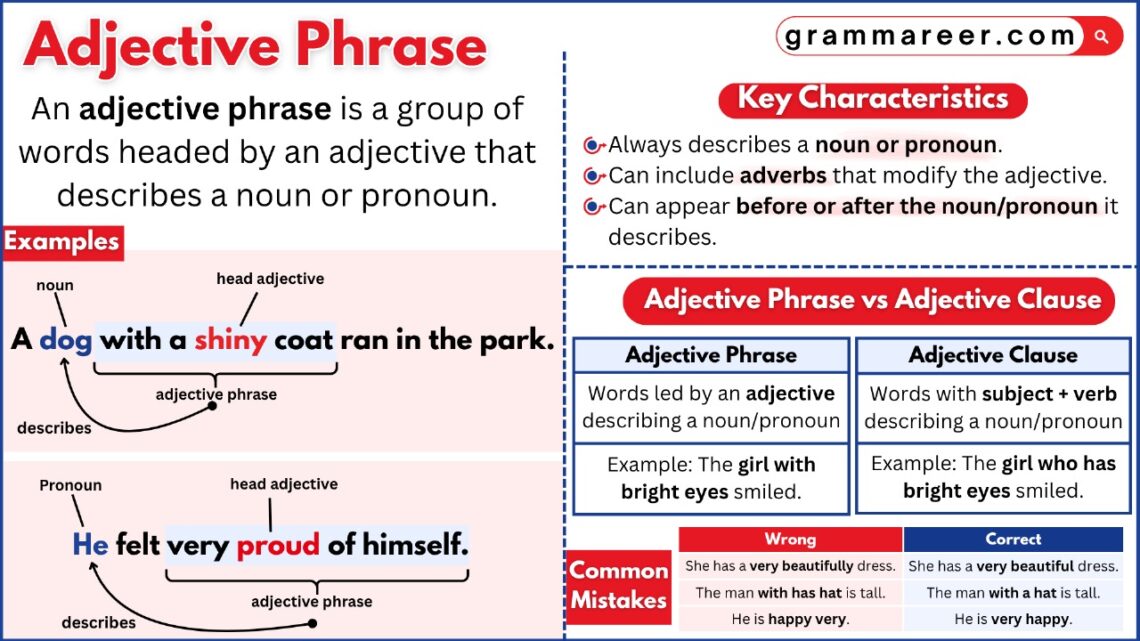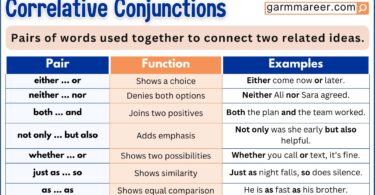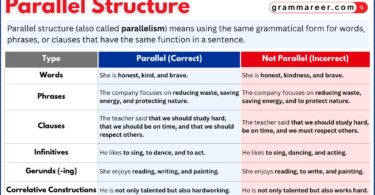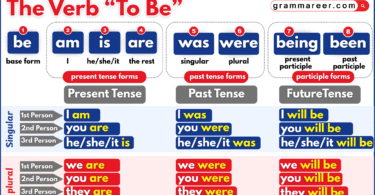When we speak or write, we often want to describe things in a little more detail. That’s where adjective phrases come in. Instead of using just one word like happy or small, an adjective phrase uses a group of words to describe a noun more clearly. For example, instead of saying a happy child, you could say a child full of joy and excitement. It gives the sentence more life and makes it easier for the listener or reader to imagine what you mean.
In this article, we’ll look at what adjective phrases are, how they’re used, and some simple examples to help you understand them better.
Table of Contents
What Is an Adjective Phrase?
An adjective phrase is just a group of words that comes together to describe a noun or pronoun. The key word in the group is always an adjective, but it can have helpers like adverbs or prepositional phrases to make the description stronger. It gives us more information about a noun or pronoun.
Okay, let’s keep this simple. You know how adjectives describe nouns, right? Words like tall, sweet, noisy. Now, sometimes one word isn’t enough. Instead of just saying a tall boy, you might say a boy much taller than his friends. That extra detail—that little group of words—is what we call an adjective phrase.
For example:
- The cake was too delicious to resist.
- We stayed in a house full of old memories.
Did you notice? how these phrases tell us more about the noun (dress, book). That’s the whole work of an adjective phrase.
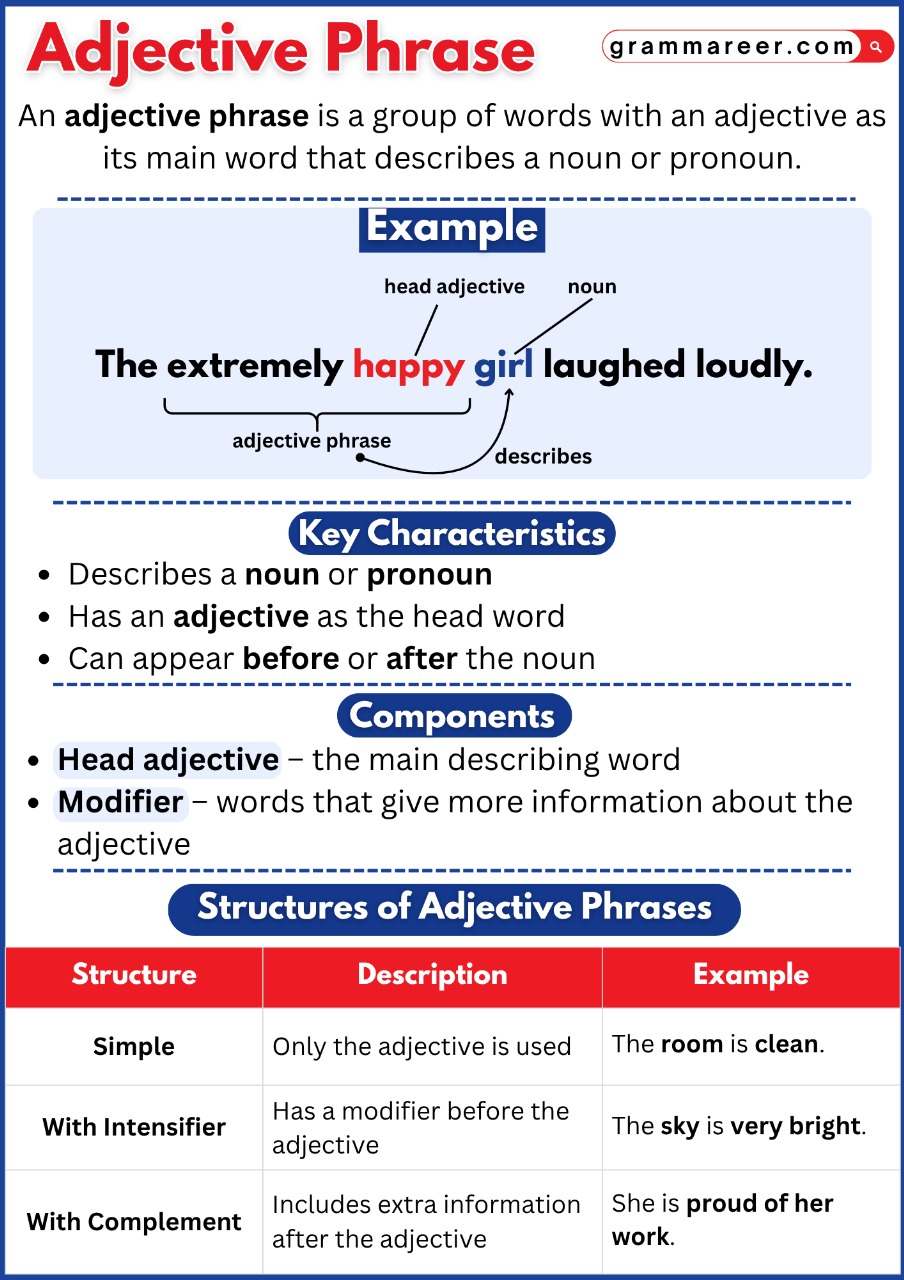
How to Identify and Use Adjective Phrases?
The easiest way to find an adjective phrase is to look for the noun first. Once you’ve found it, check if there is a group of words giving extra detail about it. If there is, that’s your adjective phrase.
For example:
- A house made of red bricks stood at the corner.
- Here, the noun is house and the phrase made of red bricks is telling us more about it.
- The meal too spicy for me to finish was left on the table.
- The noun is meal, and too spicy for me to finish is the adjective phrase.
Adjective phrases aren’t complicated they’re just extra words that make descriptions stronger and more interesting.
Now that you know how to identify them, let’s see the different ways we can actually use adjective phrases in sentences.
Using Adjective Phrases with Multiple Adjectives
Sometimes one word isn’t enough to describe something, so we use many adjectives together.
Examples:
- I liked your new pink saree.
- My mom gave away my old unused uniforms.
Using Adjective Phrases with Compound Adjectives
A compound adjective is two or more words joined together (often with a hyphen).
Examples:
- We stayed in a newly-built house.
- She enjoyed a Spanish coming-of-age series.
- The bright-eyed girl won the competition.
Using Adjective Phrases with Comparatives and Superlatives
We can also use comparing words (like taller, smarter, or most beautiful) in adjective phrases.
Examples:
- Darren is taller than his brother.
- This is the most unexpected event of the year.
Using Adjective Phrases with Prepositions
Sometimes phrases that begin with words like with, on, of, in, or about describe a noun.
Examples:
- The man on the bike is my uncle.
- I got a box of my favourite chocolates.
Using Adjective Phrases with Adverbs
Adverbs like very, really, extremely, or absolutely can make an adjective stronger.
Examples:
- We did an extremely tiring routine.
- My brother was absolutely terrified.
Adjective Phrases vs. Adjective Clauses
When we talk about adjective phrases and adjective clauses, both are used to describe nouns. The main difference lies in their structure.
- Adjective phrase: a group of words without a subject and verb, working together to describe a noun.
- Adjective clause: a group of words that has both a subject and a verb, and it also describes a noun.
| Adjective Phrase Examples: ● The tall building touched the clouds. ● She wore a dress with blue flowers. Here, “tall” and “blue” are the key describing words, while the other words expand their meaning. | Adjective Clause Examples: ● The building that touched the clouds looked amazing. ● She wore a dress that had blue flowers on it. Here, “touched” and “had” are the main verbs in the clauses, making them full clauses instead of just phrases. |
| Structure: ● Adjective + modifiers (words that give more detail) ● Prepositional phrase used as an adjective | Structure: Relative pronoun/relative adverb + subject + verb Common relative pronouns: who, whom, whose, which, that |
Prepositional Phrases as Adjectives
We already know that a prepositional phrase usually starts with a preposition (like in, on, of, about, from) and ends with a noun or pronoun. But did you know these little phrases can also work like adjectives?
When they do, they give extra information about a noun or pronoun—basically answering questions like Which one? What kind?
For Examples:
- She bought the dress with blue flowers.
- (Which dress? The one with blue flowers.)
- He is reading a story about brave soldiers.
- (What kind of story? The one about brave soldiers.)
Infinitive Phrases as Adjectives
Sometimes we use infinitive phrases (to + verb) to describe a noun or pronoun. When they do this, they act like adjectives because they tell us which one or what kind.
Think of it like this: an infinitive phrase answers questions such as:
- Which book?
- Which person?
- What kind of thing?
For Example:
- I need a pen to write my notes.
- (Which pen? The one to write my notes.)
- She has homework to finish before dinner.
- (Which homework? The one to finish before dinner.)
Attributive and Predicative Adjective Phrases
Just like single adjectives, adjective phrases can also be used in two main ways:
| Attributive Adjective Phrases When an adjective phrase comes right before the noun it describes, it is called attributive. | Predicative Adjective Phrases When an adjective phrase comes after a linking verb (like is, are, seems, looks, becomes), it is predicative. |
| Examples: ● The extremely talented young singer won the contest. (The phrase describes singer directly.) ● She bought a beautifully painted wooden table. (The phrase tells us more about table.) | Examples: ● The garden is full of colorful flowers. (The phrase tells us more about the garden after the verb is.) ● My brother looks really tired after the game. (The phrase describes brother after the verb looks.) |
Why Adjective Phrases Matter?
Adjective phrases may look small, but they make a big difference in how clear and natural your sentences sound. They help you describe nouns more accurately so people know exactly what you mean.
1. Don’t use a hyphen with words ending in -ly
If you have an adverb that ends in -ly (like nicely, quickly, beautifully), don’t join it to an adjective with a hyphen.
- ✅ Correct: She wore a beautifully decorated dress.
- ❌ Wrong: She wore a beautifully-decorated dress.
The hyphen is unnecessary because “beautifully” is clearly an adverb.
2. Use a hyphen when the word can be confusing
Some adverbs don’t end in -ly—like well, fast, more, better. In these cases, a hyphen can actually save your reader from confusion.
- ✅ Correct: He is a well-known actor.
- (Without the hyphen, it might look like “well” is an adjective meaning “healthy.”)
- ✅ Correct: This is a better-flowing design.
- (Without the hyphen, the meaning could be unclear—are the designs better or do they flow better?)
- ✅ Correct: She started eating more-nutritious meals.
- (This makes it clear she isn’t eating “more food” but food that is “more nutritious.”)
Examples of Adjective Phrases
- A very tall building
- A child full of joy
- A book too difficult to read
- A movie about brave soldiers
- A dress covered in flowers
- A car much faster than mine
- A student interested in science
- A house made of red bricks
- A cake too sweet for me
- A teacher known for kindness
- A man with blue eyes
- A girl with long hair
- A dog full of energy
- A bag heavily packed with books
- A painting worth millions of dollars
- A song hard to forget
- A street lined with tall trees
- A boy excited about the trip
- A movie worth watching twice
- A park filled with colorful flowers
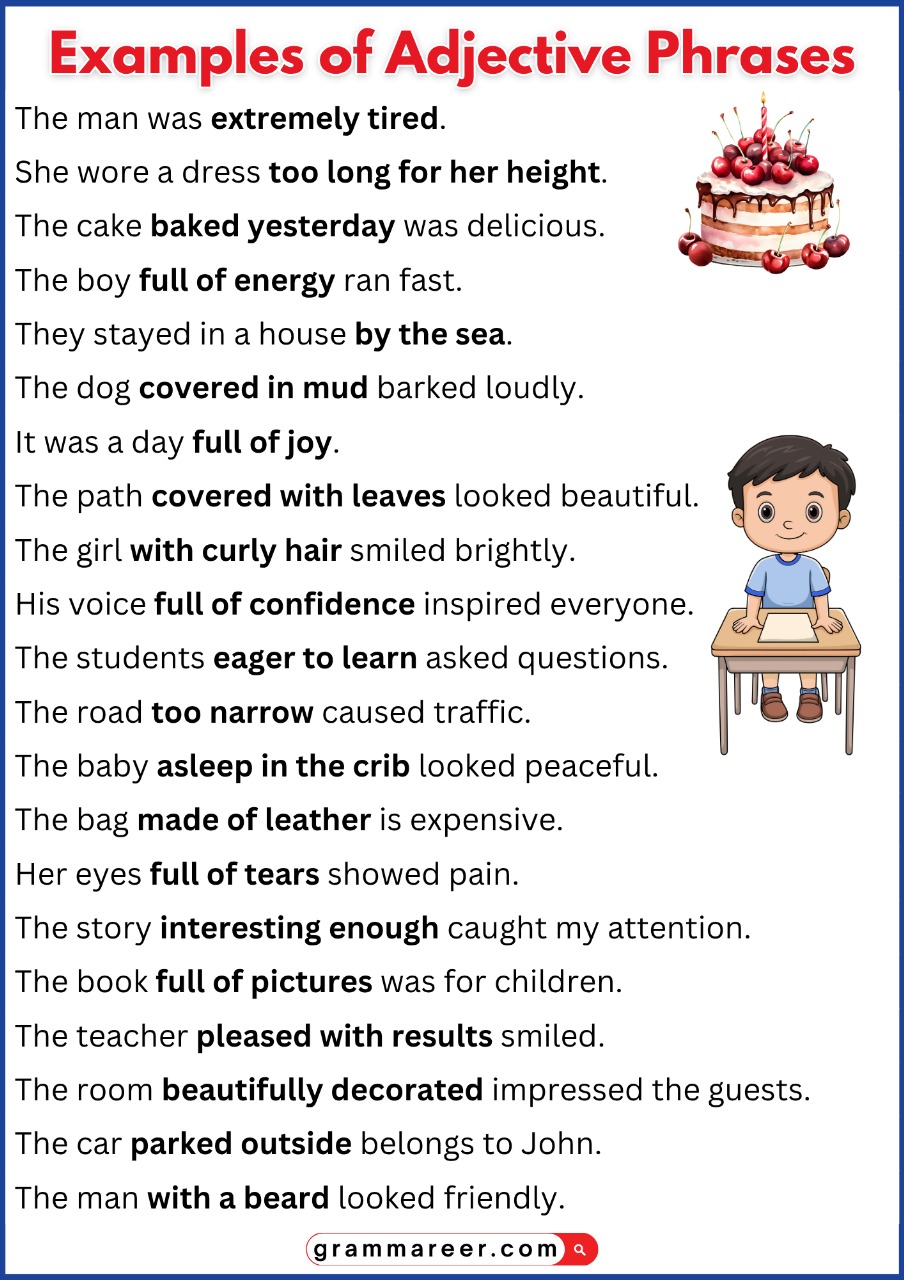
Summary
As we learned, Adjective phrases are groups of words that describe nouns or pronouns, adding detail and clarity. They can be formed with adjectives, prepositions, infinitives, or adverbs and may appear before a noun (attributive) or after a verb (predicative). Unlike adjective clauses, they lack a subject and verb. Used well, they make writing clearer, richer, and more precise.
Frequently Asked Questions about Adjective Phrases
An adjective phrase is a group of words that work together to describe a noun or pronoun. In simple words, it gives more detail about a person, place, thing, or idea. Example: a very tall building.
Look at the noun or pronoun. Then ask: What words are describing it? Those words together are likely the adjective phrase.
Sure! Here are a few:
● She wore a really beautiful dress.
● They live in a house full of old memories.
● Ali is a boy with big dreams.
● It was a movie too boring to watch.
You May Also Like

